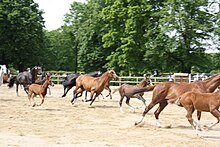Graditz main stud
|
Saxon stud administration Graditz |
|
|---|---|
| State level | State of Saxony |
| position | State company |
| Supervisory authority | Saxon State Ministry for Environment and Agriculture |
| Headquarters | Graditz |
| Authority management | Matthias Görbert |
| Web presence | http://www.smul.sachsen.de/sgv/ |
The main stud Graditz is a stud in Graditz , Saxony , a district of the city of Torgau . Graditz was a main stud of the Prussian stud administration with an important thoroughbred and half- blooded breed . Today, as the main Saxon stud , it is owned by the Free State of Saxony , along with the Moritzburg state stud . The thoroughbred breeding was privatized after the reunification, the warmblood breeding is continued in the interest of the national horse breeding.
history
The Graditz Stud was founded in 1722 by August the Strong through the merger of the existing Saxon studs or after the dissolution of horse breeding in the Electoral Saxon Court Stud Bleesern . In Graditz itself there was already an electoral Saxon stud farm in the 17th century, which has now been rebuilt. Daniel Pöppelmann was commissioned to build the stud facilities. The Saxon stud farms - including the newly founded Graditz stud farm - had the main task of covering the enormous horse needs of the Hofmarstall.
The Seven Years' War and the Napoleonic Wars created deep gaps in the horse population. After the end of the Napoleonic War Graditz became the royal Prussian main stud and in 1816 horse breeding was resumed. In 1866, Georg von Lehndorff made sure that the thoroughbreds, which had previously been distributed across various studs, were centralized in Graditz. In addition, the stock was now through imports of English thoroughbreds , z. B. the Irish stallion Dark Ronald , refreshed. In the decades after these innovations, many racing successes fell on Graditz horses, u. a. in Hoppegarten . At times the Graditzers were so successful here that extra races had to be announced, from which horses were excluded from this breed. Twelve thoroughbred horses from Graditz had won the German Derby by 1945 .
In 1922 the Graditz Thoroughbred Stud was relocated to the Altefeld main stud , and in 1930 it returned to Graditz. After the Second World War, the Graditz breeding almost came to a standstill, as a large part of the herd was transported to Russia as spoils of war and used there either for field work or even as food. Graditzers that had been sold to West Germany were used from 1948 to rebuild the stocks. Numerous racing successes were then achieved again by 1990.
The horse stable and the gatehouse were subjected to extensive renovation measures in 2006/07. This increased the capacity to accommodate guest horses for training and insemination.
Mention in the literature
The Graditz horses are mentioned in literature by Theodor Fontane , who not only lets Geert von Innstetten in Effi Briest drive a team of Isabel-colored Graditzers, but also Botho von Rienäcker in Irrungen, Verrungen in military circles lets a Graditz black mare win a game. Leopold Treibel also rides a Graditzer in Frau Jenny Treibel , who of course has been in the arena for a long time and who can no longer be trusted to extravagance.
literature
- Siegfried Graf Lehndorff : A life with horses. A contribution to the history of horse breeding . Deutscher Archiv-Verlag, Berlin 1943 (and several new editions, including: Olms, Hildesheim 1977, ISBN 3-487-08126-1 ).
- Hans Graf von Lehndorff : people, horses, wide country. Childhood and youth memories . Biederstein, Munich 1980, ISBN 3-7642-0161-4 (and numerous new editions), including Chapter 1: Graditz .
- Count Georg Lehndorff (on the occasion of his 25th anniversary as head of the Graditz main stud) In: Allgemeine Sportzeitung , January 1, 1892
Web links
- Saxon Stud Management: Website of the Moritzburg State Stud and the Graditz Main Stud
- Website of the Graditz Stud Farm
Individual evidence
- ↑ Graditz stud construction project. In: Staatsbetrieb Sächsisches Immobilien- und Baumanagement. Retrieved October 30, 2010 (PDF document; 1.46 MB)
Coordinates: 51 ° 32 '44.1 " N , 13 ° 3' 33.9" E

